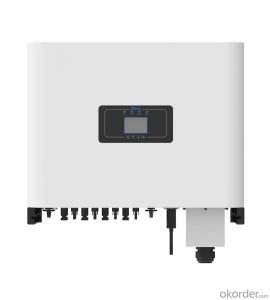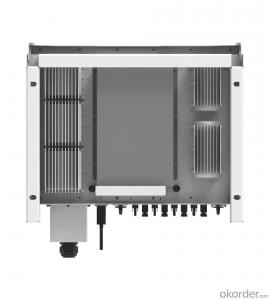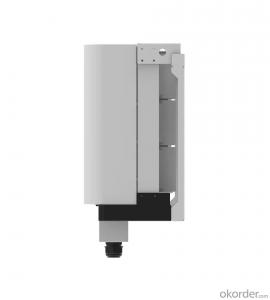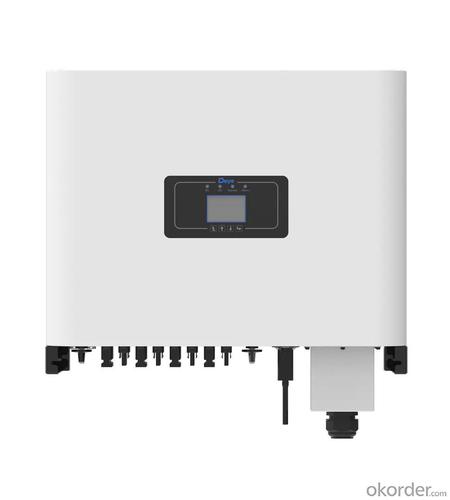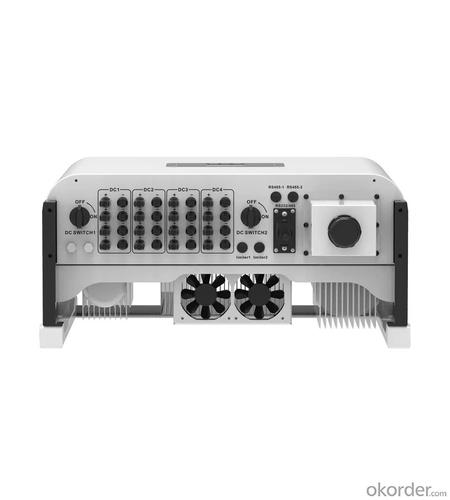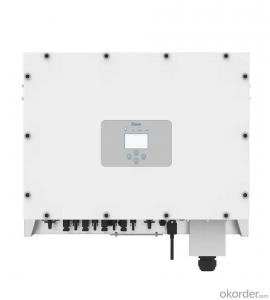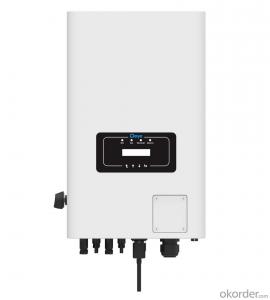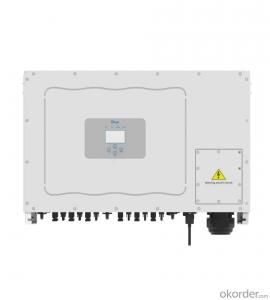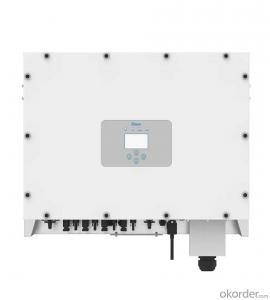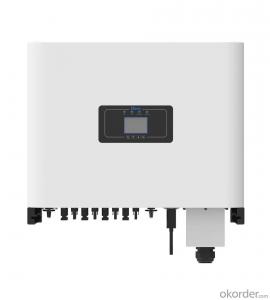Danfoss Solar Inverter - sun-30/33/35/40/50/60k-g03 | 30-60kw | Three Phase | 4 MPPT
- Loading Port:
- Ningbo
- Payment Terms:
- TT OR LC
- Min Order Qty:
- 1000 pc
- Supply Capability:
- 5000 pc/month
OKorder Service Pledge
OKorder Financial Service
You Might Also Like
Specification
| Technical Data | ||||||||
| Model | SUN-30K-G03 | SUN-33K-G03 | SUN-35K-G03 | SUN-40K-G03 | SUN-50K-G03 | SUN-60K-G03 | ||
| Input Side | ||||||||
| Max. DC Input Power (kW) | 39 | 42.9 | 45.5 | 52 | 65 | 78 | ||
| Max. DC Input Voltage (V) | 1000 | |||||||
| Start-up DC Input Voltage (V) | 250 | |||||||
| MPPT Operating Range (V) | 200~850 | |||||||
| Max. DC Input Current (A) | 40+40 | 40+40+40 | 40+40+40+40 | |||||
| Max. Short Circuit Current (A) | 60+60 | 60+60+60 | 60+60+60+60 | |||||
| Number of MPPT / Strings per MPPT | 2/3 | 3/3 | 4/3 | |||||
| Output Side | ||||||||
| Rated Output Power (kW) | 30 | 33 | 35 | 40 | 50 | 60 | ||
| Max. Active Power (kW) | 33 | 36.3 | 38.5 | 44 | 55 | 66 | ||
| Nominal Output Voltage / Range (V) | 3L/N/PE 380V/0.85Un-1.1Un, 400V/0.85Un-1.1Un | |||||||
| Rated Grid Frequency (Hz) | 50 / 60 (Optional) | |||||||
| Operating Phase | Three phase | |||||||
| Rated AC Grid Output Current (A) | 43.5 | 47.8 | 50.7 | 58 | 72.5 | 87 | ||
| Max. AC Output Current (A) | 47.9 | 52.6 | 55.8 | 63.8 | 79.7 | 95.7 | ||
| Output Power Factor | 0.8 leading to 0.8 lagging | |||||||
| Grid Current THD | <3% | |||||||
| DC Injection Current (mA) | <0.5% | |||||||
| Grid Frequency Range | 47~52 or 57~62 (Optional) | |||||||
| Efficiency | ||||||||
| Max. Efficiency | 98.7% | |||||||
| Euro Efficiency | 98% | |||||||
| MPPT Efficiency | >99% | |||||||
| Protection | ||||||||
| DC Reverse-Polarity Protection | Yes | |||||||
| AC Short Circuit Protection | Yes | |||||||
| AC Output Overcurrent Protection | Yes | |||||||
| Output Overvoltage Protection | Yes | |||||||
| Insulation Resistance Protection | Yes | |||||||
| Ground Fault Monitoring | Yes | |||||||
| Anti-islanding Protection | Yes | |||||||
| Temperature Protection | Yes | |||||||
| Integrated DC Switch | Yes | |||||||
| Remote software upload | Yes | |||||||
| Remote change of operating parameters | Yes | |||||||
| Surge protection | DC Type II / AC Type II | |||||||
| General Data | ||||||||
| Size (mm) | 647.5W×537H×303.5D | |||||||
| Weight (kg) | 44.5 | |||||||
| Topology | Transformerless | |||||||
| Internal Consumption | <1W (Night) | |||||||
| Running Temperature | -25~65℃, >45℃ derating | |||||||
| Ingress Protection | IP65 | |||||||
| Noise Emission (Typical) | <45 dB | |||||||
| Cooling Concept | Smart cooling | |||||||
| Max. Operating Altitude Without Derating | 2000m | |||||||
| Warranty | 5 years | |||||||
| Grid Connection Standard | CEI 0-21, VDE-AR-N 4105, NRS 097, IEC 62116, IEC 61727, G99, G98, VDE 0126-1-1, RD 1699, C10-11 | |||||||
| Operating Surroundings Humidity | 0-100% | |||||||
| Safety EMC / Standard | IEC/EN 61000-6-1/2/3/4, IEC/EN 62109-1, IEC/EN 62109-2 | |||||||
| Features | ||||||||
| DC Connection | MC-4 mateable | |||||||
| AC Connection | IP65 rated plug | |||||||
| Display | LCD 240×160 | |||||||
| Interface | RS485/RS232/Wifi/LAN | |||||||
This series grid-tie inverter is preferred choice for commercial PV system. With the free-standing design, it greatly reduces installation time and costs. With a Max. 4 MPPTs design and Max. capacity of 50 kW, it is scalable up to the megawatt range.
· 4 MPP tracker, Max. efficiency up to 98.7%
· Zero export application, VSG application
· String intelligent monitoring (optional)
· Wide output voltage range
· Type II DC/AC SPD
· Anti-PID function (Optional)
- Q: Can a solar inverter be used in regions with high levels of lightning activity?
- Yes, a solar inverter can be used in regions with high levels of lightning activity. However, it is important to install appropriate lightning protection measures to ensure the safety and functionality of the solar inverter system. This can include surge protection devices and grounding systems to mitigate potential damage caused by lightning strikes.
- Q: Can a solar inverter be upgraded or expanded in the future?
- Yes, a solar inverter can be upgraded or expanded in the future. Inverter technology is constantly evolving, and manufacturers often release firmware updates or offer hardware upgrades to improve performance, add new features, or increase capacity. Additionally, in case of increased energy demands or the addition of more solar panels, it is possible to expand the system's capacity by adding additional inverters or upgrading the existing inverter to a higher capacity model.
- Q: How does a solar inverter handle voltage drop in long cable runs?
- A solar inverter compensates for voltage drop in long cable runs by boosting the voltage to ensure efficient power transmission.
- Q: Can a solar inverter be used for residential applications?
- Yes, a solar inverter can be used for residential applications. A solar inverter is an essential component of a residential solar energy system as it converts the direct current (DC) generated by solar panels into usable alternating current (AC) electricity that can power household appliances and be fed back into the grid.
- Q: Can a solar inverter be used with a solar-powered security camera system?
- Yes, a solar inverter can be used with a solar-powered security camera system. A solar inverter is responsible for converting the direct current (DC) produced by solar panels into alternating current (AC) that can be used to power electrical devices, including security cameras. By connecting the solar panels to a solar inverter, the generated solar energy can be efficiently utilized to power the security camera system.
- Q: How does a solar inverter handle voltage transients?
- A solar inverter handles voltage transients by regulating and stabilizing the incoming DC voltage from the solar panels, and converting it into a steady AC voltage suitable for use in the electrical grid or for powering appliances. It uses various electronic components and control algorithms to monitor and adjust the voltage levels, ensuring that any sudden changes or fluctuations in the input voltage are smoothed out and the output remains consistent and within acceptable limits.
- Q: What are the key differences between a central inverter and a string inverter?
- The key differences between a central inverter and a string inverter lie in their design and functionality. A central inverter is a larger unit that is typically installed at a centralized location, such as a utility room, and is connected to multiple strings of solar panels. It converts the DC (direct current) electricity generated by the solar panels into AC (alternating current) electricity that can be used to power appliances or fed back into the grid. Central inverters are more suitable for larger installations, as they can handle higher power capacities and are more efficient at converting DC to AC. On the other hand, a string inverter is a smaller unit that is usually installed near the solar panels and is connected to each individual string of solar panels. It converts the DC electricity from each string into AC electricity. String inverters are more commonly used in smaller residential or commercial installations, as they offer more flexibility in panel arrangement and monitoring. They also allow for individual optimization and monitoring of each string, which can be beneficial in cases where panels may be shaded or have different orientations. In summary, while central inverters are better suited for larger installations and offer higher efficiency, string inverters provide more flexibility and individual optimization options for smaller installations.
- Q: What are the common issues and troubleshooting steps for a solar inverter?
- Some common issues with solar inverters include no power output, low power output, display or communication errors, and overheating. Troubleshooting steps for these issues may involve checking the input voltage and connections, inspecting the DC and AC cables for damage, resetting the inverter, updating firmware or software, ensuring proper ventilation and cooling, and contacting technical support if necessary.
- Q: What is the maximum power output of a solar inverter?
- The maximum power output of a solar inverter depends on its capacity and specifications. It can range from a few hundred watts to several kilowatts for residential inverters, and even higher for commercial or utility-scale inverters.
- Q: How does a solar inverter handle partial shading on solar panels?
- A solar inverter handles partial shading on solar panels by utilizing a technique called Maximum Power Point Tracking (MPPT). MPPT allows the inverter to continuously track the optimal operating point of each individual solar panel, even if some panels are partially shaded. By constantly adjusting the voltage and current levels of the panels, the inverter ensures that the shaded panels do not significantly affect the overall system performance, maximizing the energy output of the entire solar array.
Send your message to us
Danfoss Solar Inverter - sun-30/33/35/40/50/60k-g03 | 30-60kw | Three Phase | 4 MPPT
- Loading Port:
- Ningbo
- Payment Terms:
- TT OR LC
- Min Order Qty:
- 1000 pc
- Supply Capability:
- 5000 pc/month
OKorder Service Pledge
OKorder Financial Service
Similar products
Hot products
Hot Searches
Related keywords
